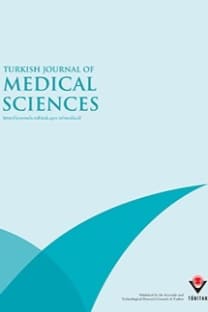Hyperactivation of the hypothalamo-pituitary-adrenocortical axis in streptozotocin diabetic rats: effect of Tinospora cordifolia (Willd.) and insulin therapy
Key words: Tinospora cordifolia, hypothalamo-pituitary-adrenal axis, diabetes mellitus, hypoglycemia, streptozotocin
Hyperactivation of the hypothalamo-pituitary-adrenocortical axis in streptozotocin diabetic rats: effect of Tinospora cordifolia (Willd.) and insulin therapy
Key words: Tinospora cordifolia, hypothalamo-pituitary-adrenal axis, diabetes mellitus, hypoglycemia, streptozotocin,
___
- 1. Roy MS, Roy A, Gallucci W, Collier B, Young K. Th e ovine corticotrophin-releasing hormone-stimulation test in type 1 diabetic patients and controls: suggestion of mild chronic hypercortisolism. Metabolism 1993; 42: 696-700.
- 2. Weitzman ED, Fukushima D, Nogeire C, Roff warg H, Gallagher TF. Twenty-four hour pattern of the episodic secretion of cortisol in normal subjects. J Clin Endocrinol Metab 1971; 33: 14-22.
- 3. Cameron OG, Kronfol Z, Grenden JF, Carroll BJ. Hypothalamic-pituitary-adrenocortical activity in patients with diabetes mellitus. Arch Gen Psychiatry 1984; 41: 1090-5.
- 4. Havel PJ, Hann TM, Sindelar DK, Baskin DG, Daff man MF. Eff ects of streptozotocin-induced diabetes and insulin treatment on the hypothalamic melanocortin system and muscle uncoupling protein 3 expression in rats. Diabetes 2000; 49: 244-52.
- 5. Nadkarni AK. Indian materia medica. 3rd ed. Bombay: Popular Prakashan; 1954. p.1221.
- 6. Gupta SS, Verma CL, Garg VP, Rai M. Anti-diabetic eff ects of Tinospora cordifolia. Eff ect on fasting blood sugar level, glucose tolerance and adrenaline-induced hyperglycem ia. Indian J Med Res 1967; 55: 733-45.
- 7. Chattopadhyay SM, Ramanathan R, Das J, Bhattacharya SK. Animal models in experimental diabetes mellitus. Indian J Exp Biol 1997; 35: 1141-5.
- 8. Stanely Mainzen Prince P, Venugopal PM, Gunasekaran G. Hypolipidaemic action of Tinospora cordifolia roots in alloxan diabetic rats. J Ethnopharmacol 1999; 64: 53-7.
- 9. Trinder P. Determination of blood glucose using an oxidaseperoxidase system with a non-carcinogenic chromogen. J Clin Pathol 1969; 22: 158-61.
- 10. Chan O, Inouye K, Vranic M, Matthews SG. Hyperactivation of the hypothalamo-pituitary-adrenocortical axis in streptozotocin diabetes is associated with reduced stress responsiveness and decreased pituitary and adrenal sensitivity. Endocrinology 2002; 143: 1761-8.
- 11. Makimura H, Mizuno TM, Isoda F, Beasley J, Silverstein JH, Mobbs CV. Role of glucocorticoids in mediating eff ects of fasting and diabetes on hypothalamic gene expression. BMC Physiol 2003; 3: 5.
- 12. Murray RK, Granner DK, Mayes PA, Rodwell VW. Harper’s Biochemistry. 21st ed. Norwalk (CT): Appleton & Large; 1988.
- 13. Puranik N, Kammar KF, Devi S. Effi cacy of Tinospora cordifolia on lipid profi le in streptozotocin induced diabetic rats. Is it benefi cial to the heart? Biomed Res 2009; 25: 45-51.
- 14. Pushparaj P, Tan CH, Tan BKH. Eff ects of Averrhoa bilimbi leaf extract on blood glucose and lipids in streptozotocin diabetic rats. J Ethnopharmacol 2000; 72: 69-76.
- ISSN: 1300-0144
- Yayın Aralığı: 6
- Yayıncı: TÜBİTAK
Itır Ebru ZEMHERİ, Asıf YILDIRIM, Mehmet Cenk GÜRBÜZ, Bayram GÜNER, Turhan ÇAŞKURLU, Sıdıka Şeyma ÖZKANLI
High cerebrospinal fluid protein level in West Nile virus encephalitis: Report of five cases
Nazan TUNA, Oğuz KARABAY, Mehmet YAHYAOĞLU, Gökçen ÖZTÜRK
The levels of serum chemokines in patients with Behçet's disease
İbrahim KÖKÇAM, Dilara TURGUT, Nafiye Fulya İLHAN, Demet ÇİÇEK
Sevi Burçak ÇEHRELİ, İlker Tolga ÖZGEN, Mehmet Emre TAŞÇILAR, Özlem AKGÜN MARTI, Günseli POLAT GÜVEN, Ceyhan ALTUN
Nagaraja PURANIK, Sheela DEVI DEVI, Kararshaha KAMMAR
Xiaodong YU, Xiangsheng ZHANG, Zhihong LI, Tang LIU, Wen ZENG
Penetrating chest injuries: analysis of 99 cases
Sadi KAYA, Koray AYDOĞDU, Ertan AYDIN, Nurettin KARAOĞLANOĞLU, Ülkü YAZICI, Alkın YAZICIOĞLU
Soner AKÇİN, Mürsel DAVARCI, Ahmet GÖKÇE, Eşref Oğuz GÜVEN, Mehmet İNCİ, Fatih Rüştü YALÇINKAYA, Mevlana Derya BALBAY
Microalbumin excretion and outcome in children with multicystic dysplastic kidney
Beyhan Cengiz ÖZYURT, İpek AKİL, Neşe BIYIKLI, Harika ALPAY, Pınar YAZICI
